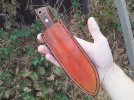- Joined
- Jul 3, 2019
- Messages
- 14,799
Hey everyone- just figured I'd share a sheath I made last night for an ESEE 3 I own.
It's pretty plain and simple but I'm pretty pleased with how I improved my process compared to some of my others.
I'm not looking for fancy, just functional- I don't use any glue, no leather treatment or even a stitching pony, just a pricking iron, needles and thread.
You can see it here in the middle of wet forming.
I'm happy to receive constructive criticism and advice, but keep in mind- I'm just looking for a way to make a thing to hold a thing.



It's pretty plain and simple but I'm pretty pleased with how I improved my process compared to some of my others.
I'm not looking for fancy, just functional- I don't use any glue, no leather treatment or even a stitching pony, just a pricking iron, needles and thread.
You can see it here in the middle of wet forming.
I'm happy to receive constructive criticism and advice, but keep in mind- I'm just looking for a way to make a thing to hold a thing.






